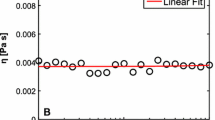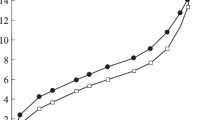Abstract
Surface energy data for samples of microcrystalline cellulose have been obtained using two techniques: capillary intrusion and inverse gas chromatography. Ten microcrystalline cellulose materials, studied using capillary intrusion, showed significant differences in the measured surface energetics (in terms of total surface energy and the acid–base characteristics of the cellulose surface), with variations noted between the seven different manufacturers who produced the microcrystalline cellulose samples. The surface energy data from capillary intrusion was similar to data obtained using inverse gas chromatography with the column maintained at 44% relative humidity for the three samples of microcrystalline cellulose studied. This suggests that capillary intrusion may be a suitable method to study the surface energy of pharmaceutical samples.

Similar content being viewed by others
Notes
A plot of cosθ against liquid surface tension for at least four liquids is extrapolated to cosθ = 1, which is recorded as the solid surface free energy, i.e. the surface tension of a liquid which will just perfectly wet the solid.
References
R. J. Good. Contact angle, wetting, and adhesion—a critical review. J. Adhes. Sci. Technol. 6(12):1269–1302 (1992).
C. M. Lehr, J. A. Bouwstra, H. E. Bodde, and H. E. Junginger. A surface-energy analysis of mucoadhesion—contact-angle measurements on polycarbophil and pig intestinal-mucosa in physiologically relevant fluids. Pharm. Res. 9(1):70–75 (1992).
C. M. Lehr, H. E. Bodde, J. A. Bouwstra, and H. E. Junginger. A surface-energy analysis of mucoadhesion.2. prediction of mucoadhesive performance by spreading coefficients. Eur. J. Pharm. Sci. 1(1):19–30 (1993).
E. Oh, and P. E. Luner. Surface free energy of ethylcellulose films and the influence of plasticizers. Int. J. Pharm. 188(2):03–219 (1999).
G. Buckton. The estimation and application of surface-energy data for powdered systems. Drug Dev. Ind. Pharm. 18(11–12):1149–1167 (1992).
B. C. Hancock, P. York, and R. C. Rowe. The use of solubility parameters in pharmaceutical dosage form design. Int. J. Pharm. 148(1):1–21 (1997).
F. Dourado, F. M. Gama, E. Chibowski, and M. Mota. Characterization of cellulose surface free energy. Drug Dev. Ind. Pharm. 12(10):1081–1090 (1998).
X. Pepin, S. Blanchon, and G. Couarraze. Powder dynamic contact angle data in the pharmaceutical industry. Pharm. Sci. Technol. Today. 2(3):111–118 (1999).
I. J. Hardy, and W. G. Cook. Predictive and correlative techniques for the design, optimisation and manufacture of solid dosage forms. J. Pharm. Pharmacol. 55(1):3–18 (2003).
N. M. Ahfat, G. Buckton, R. Burrows, and M. D. Ticehurst. Predicting mixing performance using surface energy measurements. Int. J. Pharm. 156(1):89–95 (1997).
R. C. Rowe. Correlation between predicted binder spreading coefficients and measured granule and tablet properties in the granulation of paracetamol. Int. J. Pharm. 58(3):209–213 (1990).
O. Planinšek, R. Pišek, A. Trojak, and S. Srcic. The utilization of surface free-energy parameters for the selection of a suitable binder in fluidized bed granulation. Int. J. Pharm. 207(1–2):77–88 (2000).
P. M. Young, S. Edge, D. F. Steele, J. N. Staniforth, R. Price. Dynamic vapour sorption properties of sodium starch glycolate disintegrants. Pharm. Dev. Technol. 10(2):249–259 (2005).
G. Zografi, and M. J. Kontny. The interactions of water with cellulose derived and starch derived pharmaceutical excipients. Pharm. Res. 3(4):187–194 (1986).
G. Zografi, M. J. Kontny, A. Y. S. Yang, and G. S. Brenner. Surface area and water vapor sorption of microcrystalline cellulose. Int. J. Pharm. 18(1–2):99–116 (1984).
N. D. Lang, and W. Kohn. Theory of metal surfaces—charge density and surface energy. Phys. Rev., B. 1(12):4555–4568 (1970).
B. Lawn. Fracture of brittle solids. Cambridge University Press: 1993; p 378.
P. N. Jacob, and J. C. Berg. Acid-base surface-energy characterization of microcrystalline cellulose and 2 wood pulp fiber types using inverse gas-chromatography. Langmuir. 10(9):3086–3093 (1994).
M. Gindl, G. Sinn, W. Gindl, A. Reiterer, and S. Tschegg. A comparison of different methods to calculate the surface free energy of wood using contact angle measurements. Colloids Surf., A Physicochem. Eng. Asp. 181(1–3):279–287 (2001).
P. K. Sharma, and K. H. Rao. Analysis of different approaches for evaluation of surface energy of microbial cells by contact angle goniometry. Adv. Colloid Interface Sci. 98(3):341–463 (2002).
C. D. Volpe, and S. Siboni. Analysis of dynamic contact angle on discoidal samples measured by the Wilhelmy method. J. Adhes. Sci. Technol. 12(2):197–224 (1998).
O. Planinšek, A. Trojak, and S. Srcic. The dispersive component of the surface free energy of powders assessed using inverse gas chromatography and contact angle measurements. Int. J. Pharm. 221(1–2):211–217 (2001).
V. Kumar, and S. H. Kothari. Effect of compressional force on the crystallinity of directly compressible cellulose excipients. Int. J. Pharm. 177(2):173–182 (1999).
S. Edge, D. F. Steele, M. J. Tobyn, J. N. Staniforth, and A. Chen. Directional bonding in compacted microcrystalline cellulose. Drug Dev. Ind. Pharm. 27(7):613–621 (2001).
H. Khan, J. T. Fell, and G. S. Macleod. The influence of additives on the spreading coefficient and adhesion of a film coating formulation to a model tablet surface. Int. J. Pharm. 227(1–2):113–119 (2001).
G. Buckton, and J. M. Newton. Assessment of the wettability of powders by the use of compressed powder discs. Powder Technol. 46:201–208 (1986).
G. Buckton. Assessment of the wettability of pharmaceutical powders. In K. L. Mittal (ed.), Contact Angle, Wettability and Adhesion, 437–451 (1993).
T. R. Desai, D. Q. Li, W. H. Finlay, and J. P. Wong. Determination of surface free energy of interactive dry powder liposome formulations using capillary penetration technique. Colloids Surf., B Biointerfaces. 22(2):107–113 (2001).
P. K. Sharma, K. H. Rao, K. S. E. Forssberg, and K. A. Natarajan. Surface chemical characterisation of Paenibacillus polymyxa before and after adaptation to sulfide minerals. Int. J. Miner. Process. 62(1–4):3–25 (2001).
C. J. van Oss. Acid–base interfacial interactions in aqueous media. Colloids Surf., A Physicochem. Eng. Asp. 78:1–49 (1993).
M. de Meijer, S. Haemers, W. Cobben, and H. Militz. Surface energy determinations of wood: Comparison of methods and wood species. Langmuir. 16(24):9352–9359 (2000).
J. Schultz, L. Lavielle, and C. Martin. The role of the interface in carbon-fiber epoxy composites. J. Adhes. 23(1):45–60 (1987).
V. Gutmann. The Donor-acceptor approach to molecular interactions, Plenum, New York, 1978.
F. L. Riddle, and F. M. Fowkes. Spectral shifts in acid–base chemistry.1. vanderwaals contributions to acceptor numbers. J. Am. Chem. Soc. 112(9):3259–3264 (1990).
D. Cline, and R. Dalby. Predicting the quality of powders for inhalation from surface energy and area. Pharm. Res. 19(9):1274–1277 (2002).
C. J. Van Oss. Acid–base interfacial interactions in aqueous-media. Colloids Surf., A Physicochem. Eng. Asp. 78:1–49 (1993).
C. J. Van Oss, R. F. Giese, and W. Wu. On the predominant electron-donicity of polar solid surfaces. J. Adhes. 63(1–3):71–88 (1997).
W. Wu, R. F. Giese, and C. J. VanOss. Change in surface properties of solids caused by grinding. Powder Technol. 89(2):129–132 (1996).
M. N. Belgacem, G. Czeremuszkin, S. Sapieha, and A. Gandini. Surface characterization of cellulose fibres by XPS and inverse gas chromatography. Cellulose. 2(3):145–157 (1995).
H. A. Krässig. Cellulose. structure, accessibility and reactivity, 11:Gordon and Breach Science, Amsterdam, 1993, p. 376.
M. A. Tshabalala. Determination of the acid–base characteristics of lignocellulosic surfaces by inverse gas chromatography. J. Appl. Polym. Sci. 65(5):1013–1020 (1997).
M. D. Ticehurst, R. C. Rowe, and P. York. Determination of the surface properties of 2 batches of salbutamol sulfate by inverse gas chromatography. Int. J. Pharm. 111(3):241–249 (1994).
M. G. Vachon, and D. Chulia. The use of energy indices in estimating powder compaction functionality of mixtures in pharmaceutical tableting. Int. J. Pharm. 177(2):183–200 (1999).
B. E. Sherwood, and J. W. Becker. A new class of high functionality excipients: silicified microcrystalline cellulose. Pharm. technol. 22:78–88 (1998).
M. T. Guo, F. X. Muller, and L. L. Augsburger. Evaluation of the plug formation process of silicified microcrystalline cellulose. Int. J. Pharm. 233(1–2):99–109 (2002).
S. Edge, D. F. Steele, A. S. Chen, M. J. Tobyn, and J. N. Staniforth. The mechanical properties of compacts of microcrystalline cellulose and silicified microcrystalline cellulose. Int. J. Pharm. 200(1):67–72 (2000).
D. F. Steele, M. Tobyn, S. Edge, A. S. Chen, and J. N. Staniforth. Physicochemical and mechanical evaluation of a novel high density grade of silicified microcrystalline cellulose. Drug Dev. Ind. Pharm. 30(1):103–109 (2004).
G. Czeremuszkin, P. Mukhopadhyay, and S. Sapieha. Elution behavior of chemically different probes on the evaluation of surface properties of cellulose by inverse gas chromatography. J. Colloid Interface Sci. 194(1):127–137 (1997).
J. S. Wu, H. O. Ho, and M. T. Sheu. A statistical design to evaluate the influence of manufacturing factors and material properties on the mechanical performances of microcrystalline cellulose. Powder Technol. 118(3):219–228 (2001).
R. O. Williams, M. Sriwongjanya, and M. K. Barron. Compaction properties of microcrystalline cellulose using tableting indices. Drug Dev. Ind. Pharm. 23(7):695–704 ( 1997).
F. Podczeck, and P. Revesz. Evaluation of the properties of microcrystalline and microfine cellulose powders. Int. J. Pharm. 91(2–3):183–193 (1993).
D. F. Steele, S. Edge, M. J. Tobyn, R. C. Moreton, and J. N. Staniforth. Adsorption of an amine drug onto microcrystalline cellulose and silicified microcrystalline cellulose samples. Drug Dev. Ind. Pharm. 29(4):475–487 (2003).
S. Okada, H. Nakahara, and H. Isaka. Adsorption of drugs on microcrystalline cellulose suspended in aqueous-solutions. Chem. Pharm. Bull. 35(2):761–768 (1987).
R. C. Rowe, A. G. McKillop, and D. Bray. The effect of batch and source variation on the crystallinity of microcrystalline cellulose. Int. J. Pharm. 101(1–2):169–172 (1994).
M. Landin, R. Martinezpacheco, J. L. Gomezamoza, C. Souto, A. Concheiro, and R. C. Rowe. Effect of batch variation and source of pulp on the properties of microcrystalline cellulose. Int. J. Pharm. 91(2–3):133–141 (1993).
W. A. Zisman. Relationship of equilibrium contact angle to liquid and solid constitution. In F. M Fowkes (ed.), Contact Angle, Wettability and Adhesion 43:1–51 (1964).
E. Papirer, E. Brendle, H. Balard, and C. Vergelati. Inverse gas chromatography investigation of the surface properties of cellulose. J. Adhes. Sci. Technol. 14(3):321–337 (2000).
G. Garnier, and W. G. Glasser. Measurement of the surface free-energy of amorphous cellulose by alkane adsorption—a critical evaluation of inverse gas chromatography (IGC). J. Adhes. 46(1–4):165–180 (1994).
H. P. Nguyen, N. T. Ho, M. Buchmann, and U. W. Kesselring. Experimentally optimized determination of the partial and total cohesion parameters of an insoluble polymer (Microcrystalline Cellulose) by gas solid chromatography. Int. j. pharm. 34(3):217–223 (1987).
U. Weise. Hornification—mechanisms and terminology. Paperi ja Puu—Paper and Timber. 80(2):110–115 (1998).
K. Marshall, D. Sixsmith, and N. G. Stanley-Wood. Surface geometry of some microcrystalline celluloses. J. Pharm. Pharmacol. Suppl. 24:138P (1972).
A. P. Heiner, L. Kuutti, and O. Teleman. Comparison of the interface between water and four surfaces of native crystalline cellulose by molecular dynamics simulations. Carbohydr. Res. 306(1–2):205–220 (1998).
M. Jarvis. Chemistry—cellulose stacks up. Nature. 426(6967):611–612 (2003).
J. M. Park, D. S. Kim, J. W. Kong, M. Kim, W. Kim, and I. S. Park. Interfacial adhesion and microfailure modes of electrodeposited carbon fiber/epoxy–PEI composites by microdroplet and surface wettability tests. J. Colloid Interface Sci. 249(1):62–77 (2002).
Acknowledgments
We would like to thank Frank Thielmann (Surface Measurement Systems Ltd., London) for providing the IGC data.
Author information
Authors and Affiliations
Corresponding author
Rights and permissions
About this article
Cite this article
Steele, D.F., Moreton, R.C., Staniforth, J.N. et al. Surface Energy of Microcrystalline Cellulose Determined by Capillary Intrusion and Inverse Gas Chromatography. AAPS J 10, 494–503 (2008). https://doi.org/10.1208/s12248-008-9057-0
Received:
Accepted:
Published:
Issue Date:
DOI: https://doi.org/10.1208/s12248-008-9057-0




